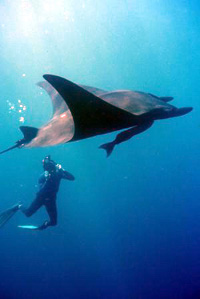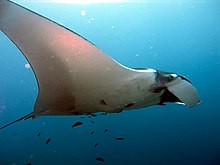Manta ray: Difference between revisions
delete edit with commercial link included |
GrahamBould (talk | contribs) No edit summary |
||
| Line 51: | Line 51: | ||
* [http://wildanimalsonline.com/fish/mantaray.php Manta Ray ''(Manta birostris)'' facts] - Wild Animals Online encyclopedia |
* [http://wildanimalsonline.com/fish/mantaray.php Manta Ray ''(Manta birostris)'' facts] - Wild Animals Online encyclopedia |
||
[[Category:Rays]] |
|||
[[Category:Rajiformes]] |
[[Category:Rajiformes]] |
||
[[Category:Myliobatidae]] |
[[Category:Myliobatidae]] |
||
Revision as of 14:17, 29 September 2006
| Manta Ray | |
|---|---|

| |
| Giant Pacific Manta. A large symbiotic suckerfish is visible on the manta's ventral side | |
| Scientific classification | |
| Kingdom: | |
| Phylum: | |
| Class: | |
| Order: | |
| Family: | |
| Genus: | Manta Bancroft, 1829
|
| Species: | M. birostris
|
| Binomial name | |
| Manta birostris Dondorff, 1798
| |
The manta ray, or giant manta (Manta birostris), is the largest of the rays, with the largest known specimen having been nearly 7.6 meters (25 ft) across its pectoral fins (or "wings") and weighed in at 3,000 kg (6,600 lb). It ranges throughout the tropical seas of the world, typically around coral reefs. Mantas are most commonly black above and white below, but some are blue on their backs. A giant manta's eyes are located at the base of the cephalic fins on each side of the head, and unlike other rays the mouth is found at the anterior edge of its head. To breathe, like other rays, the manta has five pairs of gills on the underside.
With distinctive "horns", or "cephalic fins" (from which the common name 'devil ray' stems), on either side of its broad head, the manta is a prized sighting by divers. These unique structures are actually derived from the pectoral fins. During embryonic development, part of the pectoral fin breaks away and moves forward, surrounding the mouth. This gives the Manta Ray the distinction of being the only jawed vertebrate to have evolved novel limbs (the so-called six-footed tortoise (Manouria emys) does not actually have six legs, only enlarged tuberculate scales on their thighs that look superficially like an extra pair of hind limbs). These flexible horns are used to direct plankton and water into the Manta's very broad and wide mouth. To make them more streamlined when swimming, they are able to curl them up.

Manta Rays probably evolved from bottom feeding ancestors but have adapted to become filter feeders in the open ocean. This has allowed them to grow to a larger size than any other species of ray. Because of their pelagic lifestyle as plankton feeders, some of the ancestral characterstics have degenerated. For example, all that is left of their oral teeth is a small band of vestigial teeth on the lower jaw, almost hidden by the skin. Their dermal denticals are also greatly reduced in number and size, but are still present, and they have a much thicker body mucus coating than other rays. Their spiracles have become small and non-functional, as all water is taken in through their mouth instead.
To better swim through the ocean, they have a diamond shaped body plan, using their pectoral fins as graceful "wings".
Mantas generally eat plankton, fish larvae and small organisms that are filtered out from the water by their gill rakers, a type of filter feeding that is called ram-jet feeding.
The predators of the Manta Ray include mainly large sharks, however in some circumstances killer whales have also been observed preying on them.
Taxonomically, the situation of the mantas is still under investigation. Three species have been identified: Manta birostris, Manta ehrenbergii, and Manta raya, but they are quite similar to each other, and the last two may just be isolated populations. The genus Manta is sometimes placed in its own family, Mobulidae, but this article follows FishBase, and places it in the family Myliobatidae, with the eagle rays and their relatives.
Mantas have been given a variety of common names, including Atlantic manta, Pacific manta, devil ray, devilfish, and just manta. Some people just call all members of the family stingrays.

References
- Template:IUCN2006 Database entry includes a lengthy justification of why this species is near threatened
- Froese, Rainer; Pauly, Daniel (eds.) (2005). "Manta birostris" in FishBase. 10 2005 version.
- Manta Ray entry at the Florida Museum of Natural History.
- Manta Ray FAQ at the Reef Quest Center for Shark Research.
- ARKive - images and movies of the manta ray (Manta birostris)
- The Flying Mobulas of the Sea of Cortez
- Manta Rays Archive
- Manta Pacific Research Foundation
- Manta Ray (Manta birostris) facts - Wild Animals Online encyclopedia
